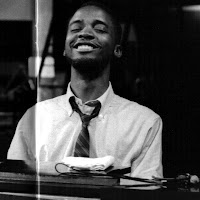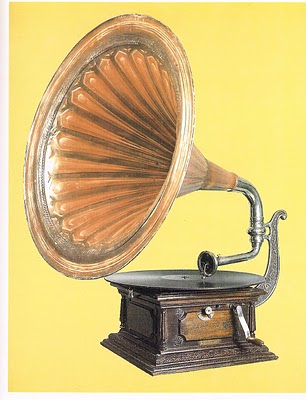190. Ahmad Jamal: Poinciana
(Buddy Bernier-Nat Simon) 1957
191. Bill Evans Trio: Come Rain or Come Shine
(Harold Arlen-Johnny Mercer) 1959
192. The Dave Brubeck Quartet: Take Five
(Paul Desmond) 1959
193. The Gerry Mulligan Quartet featuring Lee Konitz: Lady Be Good
(George Gershwin-Ira Gershwin) 1953
194. Vince Guaraldi Trio: Cast Your Fate to the Wind
(Vince Guaraldi-Carel Werber) 1963
195. Boots Randolph: Gravy Waltz
(Steve Allen-Ray Brown) 1964
196. The Nashville All-Stars: Nashville to Newport
(Chet Atkins) 1960
197. Hank Garland: All the Things You Are
(Jerome Kern- Oscar Hammerstein) 1961
198. Art Blakey and the Jazz Messengers: Dat Dere
(Bobby Timmons-Oscar Brown, Jr.) 1960
199. Oliver Nelson: Stolen Moments
(Oliver Nelson) 1961
200. Horace Silver: Song for My Father
(Horace Silver) 1964
201. Lee Morgan: The Sidewinder
(Lee Morgan) 1963
202. Donald Byrd: Slow Drag
(Donald Byrd) 1967
_______________________________________________________________________________________________________________________
"I hear you're mad about Brubeck /
Steely Dan’s Donald Fagen, in the 1981 song “New Frontier” conjures up visions of bomb shelters ("that my dad built") and Tuesday Weld and, of course, Dave Brubeck to depict a combination of angst and hope that was intended to signal suburban life in the early 1960s. The most commercially popular jazz of the late 50s and early 60s has become, for many, as it did for the jazz-influenced Fagen, the aural signature of this period – recognizable, catchy melodies on sax, trumpet, or piano over supple rhythmic support, most often loudly-mixed double-bass and drumming that incorporates a lot of snare hits and crisp rolls. Easier to understand for non-jazz audiences than the works of the genres’ acknowledged masters – Mingus, Monk, Miles Davis, and John Coltrane, the work of jazz’s lesser lights (in a very fertile era)- Dave Brubeck, Art Blakey, Horace Silver, Bill Evans, Ahmad Jamal - achieved critical and commercial success by simplifying the work of the bop masters (in a relationship not dissimilar to that between the “High Moderns” and the rest of the modernists) into a formally sophisticated, yet easily digestible form – a music for the American era John F. Kennedy, upon his election, termed “The New Frontier”.
As rock and roll's popularity increasingly fell sway to an antagonistic media’s depiction of it as merely the end result of Payola, and traditional popular singing crept ever closer to supper club irrelevance, what we have come to call post-bop, became the music of discerning listeners or, at least, of those who professed to be such - the young, the hip, the affluent denizens of an imagined Camelot. The term post-bop is something of a misnomer, and, like doo-wop, it is a useful term applied after the fact. Essentially, the term encompasses what, at the time, were referred to as cool jazz and hard bop (the tendency of many critics also to include free and out jazz within this umbrella term merely serves to render post-bop a measure of time rather than style).
The two schools, cool jazz and hard bop, were usually portrayed as opposites, with cool corresponding to the West Coast, predominantly white players who played lighter, more tightly arranged, more European-influenced jazz, while their East Coast counterparts, who played hard bop, tended to play more hard-hitting, more improvisational, more r&b influenced jazz. To contemporary ears, both schools seem to draw very heavily from the same sources – Charlie Parker, obviously, but also Miles Davis and Charles Mingus, both of whom have been proclaimed originators in both styles. What really defines cool jazz and hard bop as parts of the same larger style, post-bop, is the sense of freshness and newness that propels the best of both – it’s not called “New Frontier” jazz, but it may as well be: the era’s best music is defined by a sort of jaunty optimism suggestive of Louis Armstrong or King Oliver coupled with the calm, assuredness of Parker or Miles Davis.
In short, this is the moment at which jazz reaches critical momentum as “America’s music”; despite the actual or perceived racial divides between East and West Coasts, most of the era’s most celebrated groups were integrated and their harmonic and rhythmic sophistication seemed effortless, no longer the occasionally forced attempts at European relevance (see the Modern Jazz Quartet), but comfortably nodding to traditional jazz, swing, bop, and, even rhythm and blues. Of course, not everyone saw it that way; amateur critic Charles Mingus was extremely vocal about the commercialization of jazz, condemning its simplifications while taking credit for many of its innovations. Brubeck himself was apparently dismayed that he won widespread praise (including a 1954 Time magazine cover) before many of his (African American) idols, especially Duke Ellington. However, there is no denying that the post-bop period, from the very beginnings of cool jazz in the late 40s until the waning years of post-bop in the late 60s represent the last time that there regularly were jazz hit singles, that the Newport Jazz Festival became a major cultural event, and that jazz became the preferred music for producers of television shows and movie soundtracks. Indeed, given what follows post-bop in the history of jazz (and popular music, in general), this is the last time that contemporary jazz had a true identity in the mass media; the music that most listeners identify most readily as jazz tends to belong to this era and most contemporary jazz artists who play regularly for remuneration, fifty years later, continue to abide by the stylistic tropes of this, the post-bop era.
The sheer number of accomplished and even visionary players during this period is one of the results of the apprenticeships and cross-fertilizations that followed Charlie Parker’s ascendancy in the late 40s. Cool jazz is generally thought to begin, as do so many movements in jazz, with the mercurial Miles Davis. The 1949 and 1950 sessions eventually collected as The Birth of the Cool found Davis, still himself part of Parker’s group, experimenting with a larger, more orchestral ensemble that featured, among others, saxophonists Gerry Mulligan and Lee Konitz, trombonists J. J. Johnson and Kai Winding, pianist John Lewis, and drummer Max Roach, with some arrangements by Gil Evans. The music is less frenetic than Parker’s bop and, despite its New York
 |
| Dave Brubeck |
 |
| Ahmad Jamal |
If there is still a major sonic difference to be found between West Coast cool jazz and East Coast hard bop, it resides in the role of the piano. Hard bop’s origins are usually traced to New York City
 |
| Boots Randolph |
_________________________________________________________________________________________________________________________________________




